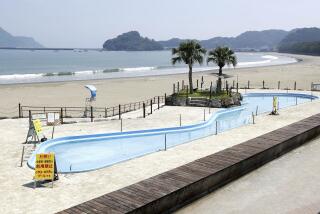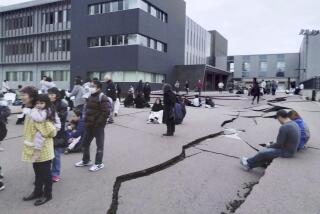Japanese face radiation risks on two fronts
- Share via
Reporting from Tokyo — Two workers at Japan’s stricken nuclear facility were hospitalized Thursday after being exposed to high levels of radiation, officials at the nation’s nuclear safety agency said. A third worker was also exposed but did not require hospitalization.
The two hospitalized workers were exposed to 170-180 millisieverts of radiation at reactor No. 3, officials said. The average American, by comparison, is exposed 6.2 millisieverts of radiation per year from natural sources, according to the U.S. Environmental Protection Agency. Dr. Robert Peter Gale, an American hematologist consulting on health issues for the workers at the Fukushima Daiichi plant, said the incident was “not serious” but shows that accidental exposures were possible.
In the late afternoon, more workers were evacuated from Reactor No. 3, Kyodo news reported.
Photos: Japan’s earthquake, tsunami and nuclear crisis
Meanwhile, in Tokyo, consumers continued to clear store shelves of bottled water a day after the government warned that infants should not be allowed to consume tap water because elevated levels of radioactive iodine from Fukushima were detected at a water treatment plant.
Water tests in Tokyo on Tuesday and Wednesday found levels of radioactive iodine-131 about double the level deemed safe for infants under the age of 1. The levels were below the unsafe benchmark for adults. Although the government said the level dropped below the infant danger threshold Thursday and the warning was lifted, residents were cautious and the government was distributing bottled water to 80,000 households with infants younger than 12 months.
Kakuzo Shiokawa was buying four small bottles of water at the Ecchu-ya convenience store in Tokyo’s Ginza district. She said her daughter-in-law was two months’ pregnant and was worried about consuming tap water. The family has been discussing whether it would be prudent to send her to Osaka, further to the southwest, for safety.
“It’s quite a panic,” Shiokawa said, even as she noted that she bought only four bottles so that “other customers could have some too.”
The death toll from the March 11 earthquake and tsunami climbed to 9,737, the National Police Agency said, and 16,501 people are still unaccounted for. Strong aftershocks continued, with a magnitude 6.1 quake rocking Miyagi prefecture shortly after 5 p.m. Some 220,000 people remain in emergency shelters.
Despite the hospitalizations of the Fukushima workers, some progress at the plant was reported Thursday. Lights were turned on at the control room of reactor No. 1.
More: Articles, videos and graphics on radiation exposure, nuclear crisis
More to Read
Sign up for Essential California
The most important California stories and recommendations in your inbox every morning.
You may occasionally receive promotional content from the Los Angeles Times.











